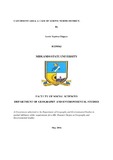Please use this identifier to cite or link to this item:
https://cris.library.msu.ac.zw//handle/11408/2124| Title: | Catchment area: a case of Gokwe north district. | Authors: | Chiguye, Lewis Tapiwa | Keywords: | Catchment area | Issue Date: | May-2016 | Publisher: | Midlands State University | Abstract: | The research aspired to estimate the potential damage a future flood can cause in Gokwe North District. The study made use of both quantitative and qualitative techniques to acquire data. This approach integrated GIS, remote sensing, semi-structured interviews and field observations in collecting data. Two Landsat images (path 171 row 72) for two different years (2005 and 2015) were accessed from U.S. Geological Survey’s Earth Explorer database. To analyse the LULC changes in the study area, these images were processed in ENVI 5.1 by exploring the K-Means in unsupervised classification method. Change detection techniques were used to compute class statistics as well as accuracy assessment. An SRTM DEM which provide data at 90m contour interval was accessed from CGIAR-CSI website and preprocessed in ArcGIS 10.1 to remove unwanted regions. The preprocessed DEM was used to calculate flow direction and map flood risk in Ilwis 3.3. Results obtained from LULC classification and flood risk mapping were inputted into SPSS software to analyse the relationship between land use and flood risk in the district. The results indicate that there were notable changes in LULC in Gokwe North District from 2005-2015. Cultivated land and built up area had significant increases whilst vegetation and water decreased. Low lying areas in the district such as Simuchembu, Madzivazvido and Nenyunka were identified to be at greater risk from flooding, Gokwe North District as a whole is a high flood risk area since it is low lying. All LULC classes in the district, that is, vegetation, cultivated land, built-up area and water have high risk levels as they often occur in lowlands. Areas close to streams are also exposed to greater risk because when the stream gets flooded these will be the first areas to be washed away. From hypothesis testing it was discovered that there is a relationship between land use and flood risk. The study recommends that organizations dealing with flood issues such as ZINWA, Meteorological Department, Civil Protection Unit of Zimbabwe and local Councils should embrace and consolidate GIS and remote sensing in flood monitoring. This would help improve the current state of flood monitoring in Zimbabwe because GIS and remote sensing have the capacity to provide information for areas of poor accessibility or lacking in ground measurements. More so use of GIS and remote sensing is an economic and efficient method of flood risk prediction because much of the data can be accessed freely. | URI: | http://hdl.handle.net/11408/2124 |
| Appears in Collections: | Bsc Geography And Environmental Studies Honours Degree |
Files in This Item:
| File | Description | Size | Format | |
|---|---|---|---|---|
| R125036J.pdf | Full Text | 1.37 MB | Adobe PDF |  View/Open |
Page view(s)
150
checked on Oct 22, 2025
Download(s)
76
checked on Oct 22, 2025
Google ScholarTM
Check
Items in MSUIR are protected by copyright, with all rights reserved, unless otherwise indicated.



